“After searching for data on home décor styling trends, Assortment Styler was the only report with details on how Americans decorate their homes. The report gave us the competitive advantage across multiple titles of knowing the top home décor styles and historical and future trends.”

How a Need Becomes a Purchase
Do you ever reflect on how you make purchase decisions? I know I do, usually when the purchase is difficult; when I realize that I’m settling for something because I haven’t found exactly what I’m looking for or because I’m not willing to compromise on what I’m looking for. Marketers call the process of recognizing a need for something, researching it, shopping for it and finally purchasing it the customer journey. A solid understanding of the customer journey results in a marketer understanding how to make the journey to their own brand and products as smooth and direct as possible. Consumer research illustrates and informs on the journey to foster that understanding.
Our research experience has taught us that most consumers are open to purchasing products from a variety of brands and from a variety of stores, both online and in-store. Behaviors range, of course, from the serendipitous purchase to the carefully planned and researched purchase. So how to understand how to steer consumers to your brand and products through the course of this journey? Start where they start. Ask yourself how they research the category. What resources can they access for information?
- Manufacturer websites – how does your stack up? Does it show up on the first page of a search? Does it supply as much information as competitor websites? Does it have the information the consumer needs to make a purchase decision? Does it answer as many questions as competitor websites? Is it as easy to navigate as others?
- Retailer websites – All the same questions for your brand on retailer sites… how do you measure up in this environment?
Here’s a tip on how to figure out if you are falling short in supplying the right information to customers on their purchase journey:
Set up a tracking system for customer service inquiries – both from online and 800 numbers. What are customers asking about? When you see patterns, you’ll see what you need to better communicate about your products in all contexts, including packaging (and you’ll save money on customer service when you reduce inquiry volumes).
But what about the customers who don’t take the time to ask the question…and just move onto other brands. Research can inform you what the key consumer information needs are in a specific product category.
Next consider the shopping experience. What stores do they shop and why, both online and in-store? Why do they shop those stores? Are your products in those stores? Should they be? Research can identify who shops in which stores. Research can identify where your current customers shop and why. Comparisons of where your customers do and don’t shop yields an understanding of where opportunities lie for your brand. Should you have more higher-end goods to reflect where they shop? Should you have more lower-priced, entry level goods to attract customers in other stores and channels?
Next consider product attributes. What are the key purchase drivers for your category and your brand? What are all the reasons why people purchase the category? Do your products check all the boxes? Is there an opportunity to fill features and price gaps in your line-up that will expand your consumer base? Is there an opportunity to fill color and design gaps in your line-up that will expand your consumer base?
Studying the customer journey is not difficult. It starts with listening to them.
Call 609.896.1108 or email Rick@designres.com and let us prepare a proposal to inform and enhance your company’s listening today.



